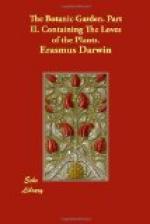Some snowdrop-roots taken up in winter, and boiled, had the insipid mucilaginous taste of the Orchis, and, if cured in the same manner, would probably make as good salep. The roots of the Hyacinth, I am informed, are equally insipid, and might be used as an article of food. Gmelin, in his History of Siberia, says the Martigon Lily makes a part of the food of that country, which is of the same natural order as the snowdrop. Some roots of Crocus, which I boiled, had a disagreeable flavour.
The difficulty of raising the Orchis from seed has, perhaps, been a principal reason of its not being cultivated in this country as an article of food. It is affirmed, by one of the Linnean school, in the Amoenit. Academ. that the seeds of Orchis will ripen, if you destroy the new bulb; and that Lily of the Valley, Convallaria, will produce many more seeds, and ripen them, if the roots be crowded in a garden-pot, so as to prevent them from producing many bulbs. Vol. VI. p. 120. It is probable either of these methods may succeed with these and other bulbous-rooted plants, as snowdrops, and might render their cultivation profitable in this climate. The root of the asphodelus ramosus, branchy asphodel, is used to feed swine in France; and starch is obtained from the alstromeria licta. Memoires d’Agricult.]
135 O’er silent floods, white hills, and glittering
meads
Six
rival swains the playful beauty leads,
Chides
with her dulcet voice the tardy Spring,
Bids
slumbering Zephyr stretch his folded wing,
Wakes
the hoarse Cuckoo in his gloomy cave,
140 And calls the wondering Dormouse from his grave,
Bids
the mute Redbreast cheer the budding grove,
And
plaintive Ringdove tune her notes to love.
Spring!
with thy own sweet smile, and tuneful tongue,
Delighted
BELLIS calls her infant throng.
145 Each on his reed astride, the Cherub-train
Watch
her kind looks, and circle o’er the plain;
Now
with young wonder touch the siding snail,
Admire
his eye-tipp’d horns, and painted mail;
Chase
with quick step, and eager arms outspread,
150 The pausing Butterfly from mead to mead;
[Bellis prolifera l. 144. Hen and chicken Daisy; in this beautiful monster not only the impletion or doubling of the petals takes place, as described in the note on Alcea; but a numerous circlet of less flowers on peduncles, or footstalks, rise from the sides of the calyx, and surround the proliferous parent. The same occurs in Calendula, marigold; in Heracium, hawk-weed; and in Scabiosa, Scabious. Phil. Botan. p. 82.]
Or
twine green oziers with the fragrant gale,
The
azure harebel, and the primrose pale,
Join
hand in hand, and in procession gay
Adorn
with votive wreaths the shrine of May.
155 —So moves the Goddess to the Idalian




